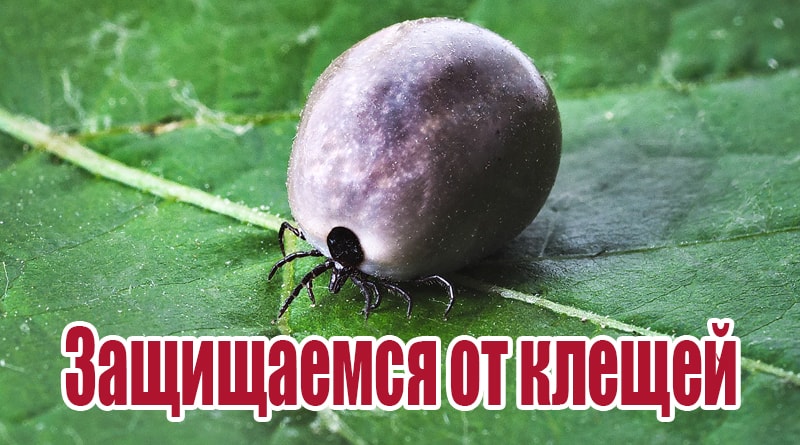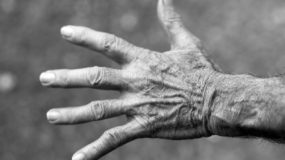In spring, when snow is falling, birds fly in, a unique aroma appears in the air, thousands of people flock to nature, to walks and barbecue. But, with good days, insects dangerous to humans come to life. Among them there are ticks, therefore, it is necessary to take measures in advance to protect them from these pests, so that you do not end up in a hospital bed.
Tick Details

Arthropods hide in green, succulent grass and easily move to humans, look for exposed skin, suck in and drink blood. A person does not feel a tick bite, since there are painkillers in the saliva of the parasite. Pathogenic viruses enter the bloodstream with saliva, causing serious illness.
When ticks wake up and when they fall asleep
The period of parasite activity begins with the establishment of a constant positive temperature, with high spring humidity and warming of the earth's surface to 5-8 degrees. As a rule, this is March, April. At this time, the first flowers bloom, leaves only appear on the trees. At the beginning of spring there are not so many of them, and they are not yet dangerous for people. Ticks after a long hibernation look for food and smell the appearance of a suitable object for 10, or even 15 meters. They gain strength by biting birds, animals. They may even attack their brethren, eating saturated blood.
The peak of tick activity is May. Once on a person’s clothes, they strive to where the skin is thin, delicate. It is behind the ears, on the neck, in the armpits, the bends of the elbows and under the knees, the inguinal region, the head. This month is most active when parasites attack. During this period, you should abandon hiking in the forest or choose the appropriate protective suit and deterrents.
The second peak of aggressiveness occurs in the fall. They do not like the summer heat, and they are engaged in reproduction, and they are not so active in hunting. In the autumn, before winter suspended animation, they are in a hurry to stock up on nutrients and again go hunting. Ticks fall asleep with a decrease in temperature to zero degrees.
Types of Ticks
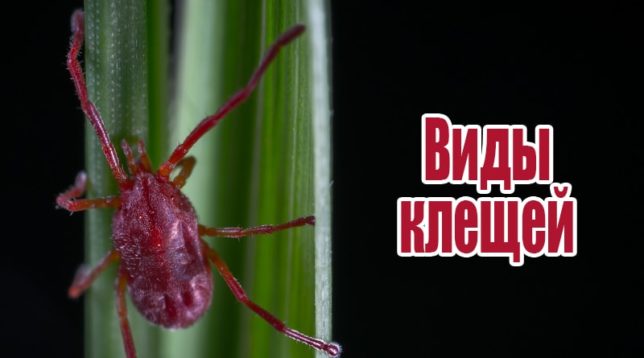
In total, over 40,000 species of ticks have been identified, which are divided into 2 main orders.
Squad No. 1. Parasitic
The first detachment includes - ixodic, gamazovye, argasovye, nuttali individuals.
- Ixodic (taiga). Representatives of the species reach a size of up to 2.5 cm, have a solid chitinous coating. They live throughout Eurasia, hiding among green leaves. Parasitize on all warm-blooded: birds, animals, people.
- Gamazovye. The size of this arachnid is about 1 mm. The life cycle is short - 7 months. Parasitize on birds and rodents.
- Argasovye. They suck blood from birds, domestic animals, humans. The integument is soft, the head goes inside the body. Tick bite painful, causing terrible itching and rash.
Squad No. 2. Acariform
To the order of acariform include: scabies, armored, hairy, feather, sarcopiform, freshwater, tyroglyphoid, thrombiform. Here is a description of some of them.
- Armored do not apply to parasites.They feed on plants, mushrooms, lichens, carrion. For birds and animals are threatened in the form of worms. Carapace mites are their carriers.
- Subcutaneous parasitize on the skin of humans and animals for several years. The food is dead skin cells. A person infected with a tick experiences constant itching, redness of the skin.
- Dusty prefers to eat dust, fluff, feathers, exfoliated epidermis. Becomes the cause of bronchial asthma in humans.
Hayers - individual scientists distinguish them in the third group.
Common Habitats
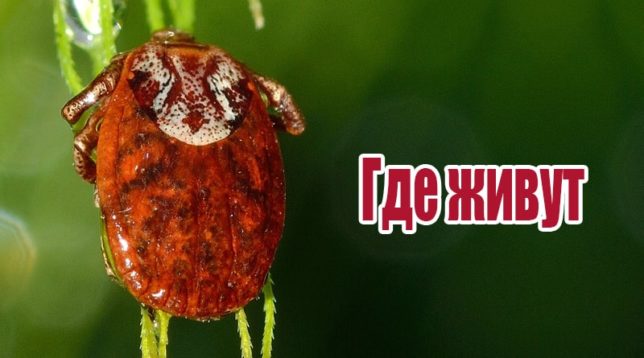
In Russia, the spread of ticks is very extensive and stretches from the European part to Siberia and the Far East. They prefer to settle in well-moistened places, among tall grass, forests, along the banks of forest rivers, near springs, paths.
Their favorite places are trails framed by grass. This is due to the fact that animals, people move about them, the smell of which attracts ticks. Deep in the forest, their concentration is much less. Not only in forests you can encounter dangerous insects, but also in meadows and rivers.
How many live
There are many types of ticks, each has its own life cycle. Consider an ixodid tick. His life is divided into four periods:
- Egg.
- Larva.
- Nymph.
- Imago (adult).
Each stage takes a certain time. This happens for several weeks, and sometimes several months. It all depends on the availability of adequate food and weather conditions. The full cycle of the taiga tick is at least 6 months, and sometimes drags on for 8-10 years. On average, they live 2 years. Each subsequent stage is impossible without saturation with blood, so until the next owner is found, life seems to freeze.
A tick without food has existed for years, waiting for the onset of favorable conditions for the transition to the next stage of development.
The bed parasite has a lifespan of about four months. It all depends on the cleanliness of the owners, how often cleaning is carried out using special tools. The bed tick does not tolerate fresh air and sunlight.
How to attack people and animals
Two species are especially dangerous for humans: ixodic and argas. How do they get on the host’s body? Argas mites do not consider a person to be the main object of nutrition, so they rarely attack him. Ixodic parasites most often attack people during their stay in nature. Ticks are inactive. Usually they sit in the grass and do not climb above 50 cm from the ground. Waiting for a potential victim, they can freeze for several months.
Parasites are placed, spreading their legs. They have sensitive receptors that help to feel the approach of a warm-blooded object for several meters. The paws have tenacious hooks, and as soon as they are touched by an animal or person, they immediately cling to clothing or wool. Then they get to the open skin, become fixed and begin to suck blood.
Than dangerous
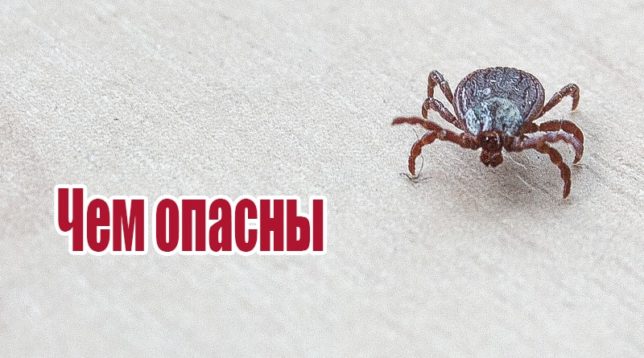
Tick saliva contains not only viruses harmful to humans, but also various biologically active additives that are also harmful. Once in the blood, saliva has the following effect:
- Anesthesia, which prevents timely notice of a bloodsucker.
- Suppression of immunity.
- The destruction of the walls of blood vessels, which ensures the unhindered flow of blood into the proboscis of the insect.
Not all ticks contain viruses, but the risk of infection is great. Therefore, even if it was possible to quickly detect the parasite, it is necessary to take it to the laboratory and find out whether the individual is dangerous or not. If there are viruses, start treatment quickly.
What diseases do
- Tick-borne encephalitisaffecting the nervous system, causing inflammation of the brain. Without timely treatment, it ends in death.
- Borreliosis - Another dangerous disease that affects the central nervous and cardiovascular system. Can be treated with antibiotics. If not detected on time, disability is at risk.
- Hemorrhagic fever. Viruses suppress the activity of almost all internal organs.Without timely treatment, death is possible.
- Typhoid Infectious disease with fever, dizziness, and intoxication.
Animals also suffer from parasite bites. Without the help of a veterinarian, death occurs.
Encephalitis tick vaccine for humans
In order for the body to develop stable immunity against encephalitis, vaccination is carried out in two stages. The first vaccination is done in the fall. In this case, by spring, a person will already be protected from an insidious disease. The next vaccination in a month, at the beginning of winter. A second vaccination is allowed after 3 months. This design guarantees safety in the event of a tick attack. Revaccination is carried out after a year or 9 months.
There is another scheme. The second vaccine is given after 2 weeks, after which the third is given after 3 months. Repeat the pattern annually.
Types of vaccines
- Of domestic vaccines, EnceVir is used. Not recommended for children.
- For children and adults, EnceVir Neo is suitable.
- Well-established German drug "FSME Immun" and the Austrian "Ensepur". They are remarkably tolerated even from a year old.
Where to do
In the Far East, which is considered an unfavorable region in terms of tick-borne encephalitis, the planned vaccinations of the population are being carried out. Medical institutions are waiting for citizens on dates approved by the State Sanitary and Epidemiological Service and at the place of work. Children are vaccinated in schools and clinics.
People who are not shown the mandatory vaccination against tick-borne encephalitis, but have a desire, can go to paid clinics or the usual district, but on a paid basis. If you plan a trip from the central regions of Russia to the Far East, then you must first be vaccinated. The distribution area of the dangerous tick is increasing every year and the vaccine is available in almost all regions of the country.
How much is

The price depends on the manufacturer. Domestic drugs are more affordable, their cost is in the range of 550-750 rubles. Imported funds are more expensive, in the region of two thousand rubles. Planned vaccinations in disadvantaged areas are free.
Is it possible to vaccinate children
Vaccination against encephalitis in children is allowed from a year. For them, “FMSE Immune Junior” and the children's form “Ensepur” are appointed.
Is vaccination harmful
Vaccination is considered safe, but there are a number of contraindications in which it is forbidden to do it.
- Allergic reaction.
- Decreased immunity.
- Acute infections.
- Pregnancy and the first months after the birth of the baby.
- Acute and chronic diseases of the liver, kidneys.
Side effects and adverse reactions to vaccine administration sometimes occur.
- In the area of vaccination, redness and hardening appear. It usually takes about five days.
- Often there is a slight increase in temperature.
- There are reactions similar to a viral infection: general malaise, joint, headaches. Specialist assistance will be required.
- An allergic reaction, up to the development of anaphylactic shock.
- It happens that a high temperature appears and lasts too long, suppuration appears at the injection site, convulsions. This occurs when using an expired vaccine or improper storage. For these symptoms, see your doctor right away.
Popular ways to protect against ticks
Folk remedies are affordable, safe and effective. Some of them scare away, others neutralize, while others do both.
- Essential oils. A glass, with a capacity of 100 ml, fill with water and add several oils there: eucalyptus, cloves, spruce and tea tree oil, half a teaspoon each. Stir well, grease exposed skin, sprinkle clothing. Parasites do not tolerate these aromas, and will not attack.
- Geranium. Mix 2 tsp. plant oils with the same amount of alcohol in a glass of water. Store the mixture in a container with a tight lid. Within six months, the solution retains its properties perfectly. It is sprayed onto clothing and exposed skin.
- Apple vinegar. Required: 50 ml of apple cider vinegar, 10 ml of any liquid soap, a little “Starlet” ointment on the tip of a teaspoon, 200 ml of water. Mix everything thoroughly. Put in a vial with a lid. Before walking, wipe bare skin.
- Garlic. You can eat a clove of garlic, grease them with hands, neck, calves and other open areas of the body.
- Ants. People working in the forest for a long time have a proven method of protection against bloodsuckers. Outerwear is placed for a quarter of an hour in an anthill. Then shake off the insects. Thus they are protected from attack by parasites. You can use pharmacy formic alcohol. Lubricate their clothes and skin.
- Vanillin. Dissolve a bag of spices in a liter of water, boil, cool and rub the skin, sprinkle clothes. The tick smell of vanillin is also unpleasant.
When hiking in the forest, you need to choose the right clothes. It should be with a long sleeve, light tone, so that individuals were immediately visible on it. On his feet trousers tucked into rubber boots, and a hat.
Folk remedies disappear quite quickly, so after an hour or two, the treatment should be repeated.
Purchased chemistry against ticks: pros and cons
Anti-mite aerosol “Deadly Force” - 3 in 1
It acts against ticks, mosquitoes, nests, and other blood-sucking animals that live in different climatic zones.
☞ Advantages:
- Kills parasites instantly.
- Long-acting drug (up to 15 days).
- Easy to apply.
- It is allowed to process in addition to clothes and open areas of the body.
- It does not wash off even when swimming in the river.
- Suitable for children.
- Minimal risk of an allergic reaction.
☞ Disadvantages: with intensive application can negatively affect health.
Spray "Breeze-antic tick"
☞ Advantages:
- Suitable for children and adults.
- Low toxicity.
- It scares off parasites and prevents them from approaching.
- It is not washed off when water gets into it.
- Does not cause an allergic reaction.
- Without smell.
- Affordable price.
☞ Disadvantages:
- It acts only against ticks.
- There are side effects.
- It scares away bloodsuckers, but does not kill.
Aerosol "Gardex Extreme"
Effectively against any harmful insects, including ticks.
☞ Advantages:
- The smell is neutral.
- For children and adults.
- Quickly kills parasites.
- Available at a price.
☞ Disadvantages:
- Toxic
- There are allergic reactions.
- Apply only to clothing.
What to do if the tick bit and sticks
To remove the tick, it is better to contact the doctors, but if this is not possible, you will have to try to remove the sucked parasite yourself. The longer it sucks blood, the higher the likelihood of contracting a dangerous disease.
Is it possible to try to shoot on my own and how
It is necessary to pull out at home very carefully, not allowing the body to rupture. Use for this curved tweezers, which is sold in pet stores and pharmacies. They try to capture the insect closer to the proboscis and then begin to pull, while rotating it. Usually it is enough to turn 1-3 times to remove completely.
In the absence of tweezers, an ordinary thread will do. It is tied around the tick body closer to the nose and begin to swing, gradually pulling out. If the head comes off, you must try to remove it as a splinter with a needle, and then treat the skin with alcohol.
Hospital removal
Removing a sucking parasite is best in a hospital. An experienced surgeon will remove the dangerous insect with the help of a suitable tool, treat the bite site, and send it for analysis. The tick itself will be checked for the presence of encephalitis viruses and a bitten person.
Where to take the tick for analysis
After the tick is removed, it must be placed in a container and taken for examination. Both public and private institutions are involved in this.
- Sanitary and epidemiological stations.
- Emergency rooms, clinics, hospitals.
- Private medical facilities.
Simultaneously with the study of the tick, the doctor will direct for analysis, so that, if necessary, in time to begin treatment.
Useful Tips
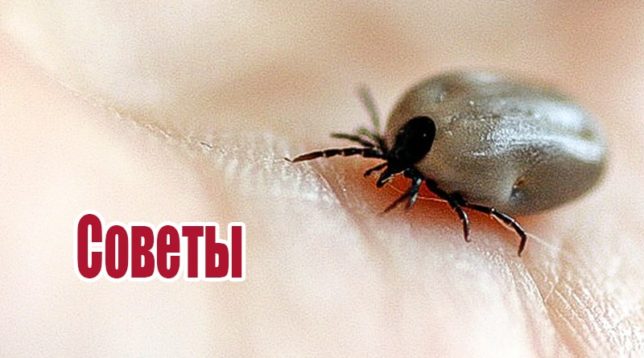
- When going to the forest, always dress appropriately - cover as much as possible with clothing all areas of the body, do not forget the headgear.
- To minimize the likelihood of a tick attack, take along special protective equipment or something from folk remedies, convenient ready-made sprays and aerosols.
- Periodically inspect clothing, exposed areas of the body in time to notice the insect. Pay attention to the neck, armpits, and inguinal region.
- The shops sell special suits in which it is safe to walk through the woods.
A tick is difficult to immediately see or feel its bite, since the saliva of the parasite contains an anesthetic and the person does not feel pain. And their bites happen quite often. The activity of bloodsuckers lasts almost the entire warm time, so it is so important to observe precautions, because an arthropod can carry a mortal threat.

